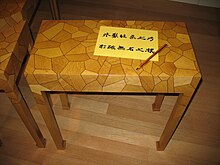Marquetry
This article needs additional citations for verification. (June 2011) |

Marquetry (also spelled as marqueterie; from the French marqueter, to variegate) is the art and
Marquetry differs from the more ancient craft of inlay, or intarsia, in which a solid body of one material is cut out to receive sections of another to form the surface pattern. The word derives from a Middle French word meaning "inlaid work".
Materials
The veneers used are primarily woods, but may include bone, ivory, turtle-shell (conventionally called "
The French cabinet maker
The simplest kind of marquetry uses only two sheets of veneer, which are temporarily glued together and cut with a fine saw, producing two contrasting panels of identical design, (in French called partie and contre-partie, "part" and "counterpart").

Marquetry as a modern craft most commonly uses knife-cut veneers. However, the knife-cutting technique usually requires a lot of time. For that reason, many marquetarians have switched to fret or scroll saw techniques. Other requirements are a pattern of some kind, some brown gummed tape (this kind of tape is used because as its moistened glue dries the tape shrinks, pulling the veneer pieces closer together), PVA glue and a base-board with balancing veneers on the alternate face to compensate stresses. Finishing the piece will require fine abrasive paper, always backed by a sanding block. Choices of sealers and finishes that can be applied include ordinary varnish, special varnishes, polyurethane (either oil or water based), wax, and French polish.
Sand shading is a process used to make a picture appear to be more three-dimensional. A piece of veneer to be incorporated into a picture is partially submerged in hot sand for a few seconds.
Another shading process is engraving fine lines into a picture and filling them with a mixture of India ink and shellac.
History
Furniture inlaid with precious woods, metals, glass and stones is known from the ancient world and Roman examples have been recovered from the first century sites of
| External videos | |
|---|---|
 | |
Techniques of wood marquetry were developed in
Marquetry was not ordinarily a feature of furniture made outside large urban centers. Nevertheless, marquetry was introduced into

Although marquetry is a technique separate from inlay, English marquetry-makers were called "inlayers" throughout the 18th century. In Paris, before 1789, makers of veneered or marquetry furniture (ébénistes) belonged to a separate guild from chair-makers and other furniture craftsmen working in solid wood (menuisiers).
Tiling patterning has been more highly developed in the Islamic world than anywhere else, and many extraordinary examples of inlay work have come from Middle Eastern countries such as Lebanon and Iran.
At Tonbridge and Royal Tunbridge Wells, England, souvenir "Tunbridge wares"—small boxes and the like—made from the mid-18th century onwards, were veneered with panels of minute wood mosaics, usually geometric, but which could include complicated subjects like landscapes. They were made by laboriously assembling and gluing thin strips and shaped rods, which then could be sliced crossways to provide numerous mosaic panels all of the same design.
Marquetry was a feature of some centers of German cabinet-making from c. 1710. The craft and artistry of David Roentgen, Neuwied, (and later at Paris as well) was unsurpassed, even in Paris, by any 18th-century marquetry craftsman.
Marquetry was not a mainstream fashion in 18th-century Italy, but the neoclassical marquetry of Giuseppe Maggiolini, made in Milan at the end of the century is notable.
The classic illustrated description of 18th century marquetry-making was contributed by Roubo to the Encyclopédie des Arts et Métiers, 1770.
New techniques
During the 1980s Georges Vriz developed a technique called technique VRIZ, layering two veneer layers on top of each other and sanding through the top one, to the point of fiber transparency. This has been used mainly in France, by professionals and marquetry students of the École Boulle. With its technique, Georges Vriz promoted a resurgence of the marquetry he called RENAISSANCE. He launched the contemporary marquetry. In the US the technique has been used at the American School of French Marquetry by one of the teachers, artist Patrice Lejeune. The school staff is also proposing a new name for it: "Given that 'piercing' is an unfortunate mistake in the veneering world, we chose to use the word "Fusion" instead, by which term the artist expresses his intention of sanding through the veneer as a decorative, textural effect, not as a mistake."
-
VRIZ - ombres et lumières. (1994)
-
VRIZ - empreinte (1985)
-
VRIZ - Femme aux violons (1984)
-
VRIZ - Espace (200x240 cm)
Cutting-edge tech has also been applied to marquetry. Among these is laser cutting, where the design is drawn or imported as a CAD or vector file and each piece is cut separately; each different species of wood-and thickness-may need a specific adjustment of the beam power; the offset will determine the gap between the pieces. In some cases, the beam will leave a dark edge due to the high heat required by the process.
See also
- Parquetry
- Woodworking
- Lath Art
- Khatam
- Intarsia
- Damascening
- Yosegi
- Charles Spindler
References
- ^ Boxwood turns golden-tan as it ages.
- ^ "Archived copy". Archived from the original on 2018-11-24. Retrieved 2018-12-08.
{{cite web}}: CS1 maint: archived copy as title (link)
External links
- . Encyclopædia Britannica. Vol. 17 (11th ed.). 1911. pp. 751–752.
- A Short History of Marquetry Includes a glossary.
- The Gubbio Studiolo and its conservation, volumes 1 & 2, from The Metropolitan Museum of Art Libraries (fully available online as PDF), which contains material on marquetry




